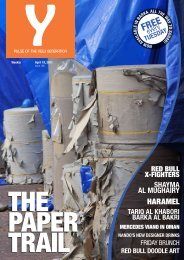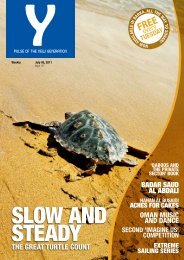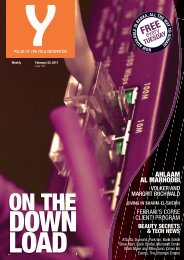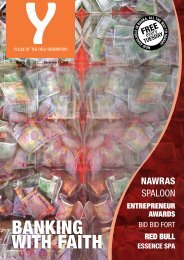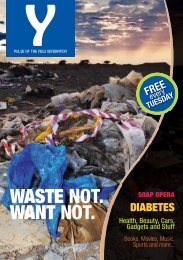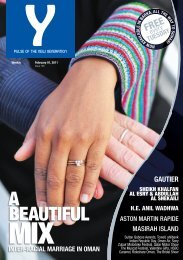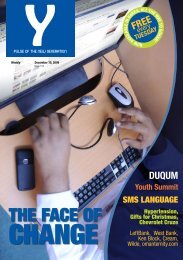Y - Issue 246 - November 27, 2012 - Y-oman.com
Y - Issue 246 - November 27, 2012 - Y-oman.com
Y - Issue 246 - November 27, 2012 - Y-oman.com
Create successful ePaper yourself
Turn your PDF publications into a flip-book with our unique Google optimized e-Paper software.
special feature<br />
<strong>November</strong> <strong>27</strong>, <strong>2012</strong> <strong>Issue</strong> <strong>246</strong><br />
fieldwork, firstly in the vast deserts of<br />
Rub al Khali, before moving to the Dhofar<br />
Mountains. The Arabian Leopard is the<br />
main focus which is very rarely seen by<br />
human eye. Last year, when the team<br />
arrived to try and capture it on camera<br />
they had a rare treat.<br />
“I remember opening up the camera trap,<br />
it was so exciting when we saw we had<br />
captured pictures of two leopards,” recalls<br />
Soo Redshaw, who will be leading the<br />
2013 expedition.<br />
“It was euphoric we were hugging each<br />
other. It’s like solving a detective story. It is<br />
such an iconic beautiful animal. They are<br />
never far from you at times, a few hundred<br />
metres at most.”<br />
The British Exploring Society was set up<br />
in 1932 by Surgeon Commander George<br />
Murray Levick, a member of Captain<br />
Scott’s final Antarctic expedition, as<br />
a way of encouraging leadership and<br />
team building through exploration. And<br />
the BES is looking for Omanis to join its<br />
next expedition in 2014. You will need<br />
to <strong>com</strong>mitto eight weeks of expedition,<br />
looking at Nubian artifacts in the Empty<br />
Quarter before tracking the Arabian<br />
Leopard in the Dhofar Mountains.<br />
It also helps to promote just how tenuous the<br />
Arabian Leopard’s position has be<strong>com</strong>e.<br />
The threats to their environment still exist.<br />
Land clearance for livestock grazing is a<br />
major problem, as are poachers. Not those<br />
who hunt the leopard, but those who hunt<br />
what the leopard hunts, like the ibex and<br />
the gazelle.<br />
“The government is creating lots of roads<br />
and infrastructure in remote areas in<br />
Dhofar and that pushes the leopard into<br />
small areas,” explains Al Hikmani.<br />
“They need a large home range and they<br />
might not find a lot of resources. It’s killing<br />
them indirectly and unintentionally.”<br />
But the situation is changing. Money is<br />
being invested and there is, as one of<br />
the scientists on last year’s trip said,<br />
“real hope” that the leopard population<br />
can be saved. But that’s not enough for<br />
The Leopard Man. Hadi al Hikmani is<br />
playing the long game in trying to protect<br />
the only big cat in the Middle East. “We<br />
want to conserve what we have but it’s<br />
also a chance to increase the leopard<br />
population,” he says.<br />
“It could be 500 or more. There are<br />
demands on the land, livestock grazing,<br />
they are all interconnected. When you<br />
solve one problem another presents itself.<br />
But in 50 years time, it might be possible."<br />
For more information on the next expedition<br />
contact Paul McGreavy at Al Takween<br />
by email dhofarexpedition@gmail.<strong>com</strong> or<br />
by calling 933 63204. You can find out<br />
more about previous expeditions on the<br />
British Exploring Society’s website www.<br />
britishexploring.org<br />
26



